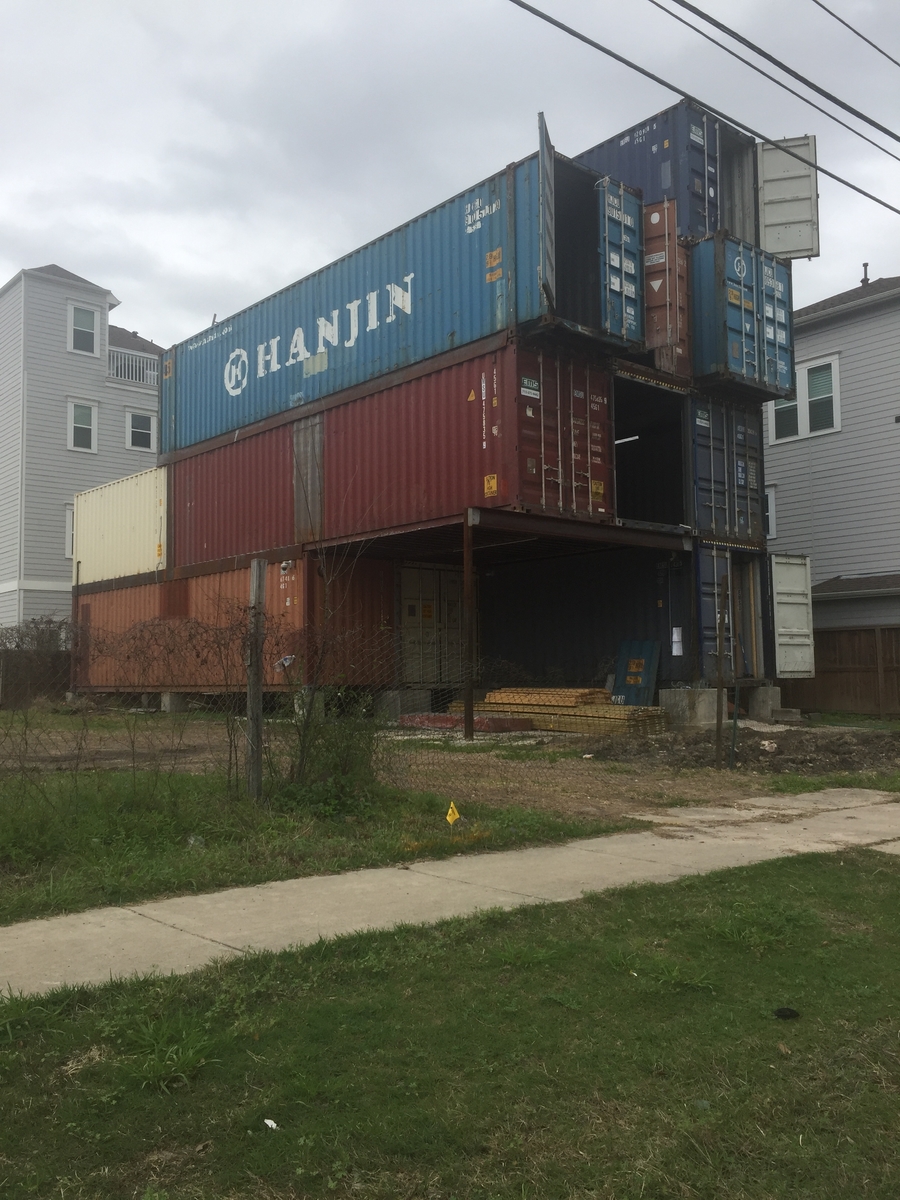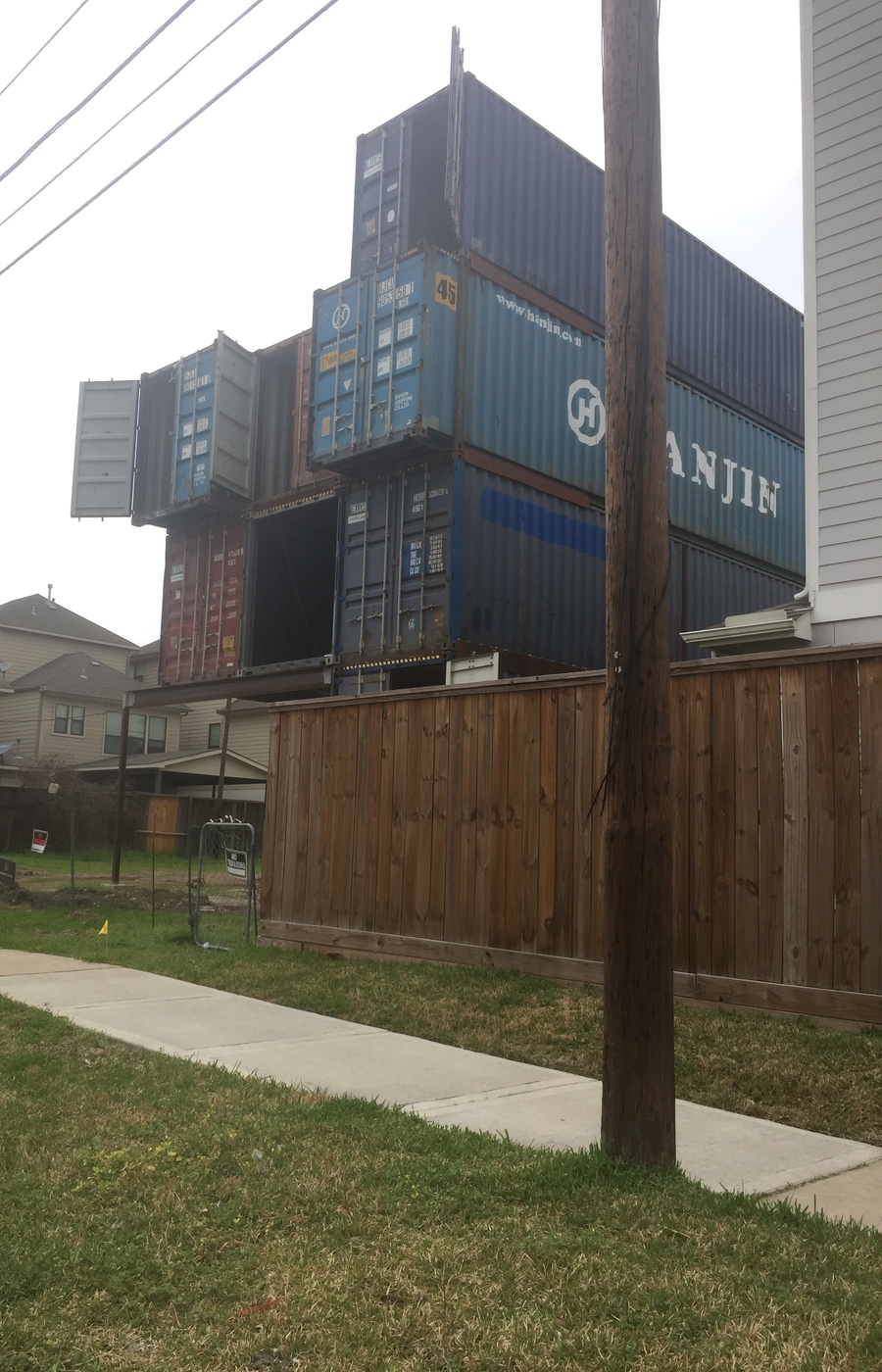

When the owner’s work is finished on what he’s calling the McGowen Container House, the stack of boxes just east of 59 will be a 4-story house with a carport at ground level and a terrace atop the blue Hanjin unit shown in the photo above. A few windows, doors, and portions of the staircase that will climb through the building’s east side have been installed, according to the blog for the project. Rough-in plumbing and some preliminary electrical wiring is finished as well, but the utilities aren’t on yet.
Here’s a view of the cargo hold from the east, near Hutchins St.:
***

Townhouses abut the structure on 2 sides. Across a vacant lot to the west, a few houses forged from more traditional construction techniques sit on the corner of St. Emanuel St.
- Project Background [McGowen Container House]
Photos: Swamplot inbox





I hope they leave the exterior au naturel.
Give the neighbors something interesting to look at
That’s a gorgeous home right there. Should fit right in with the neighborhood.
Too early to tell if this is going to end up looking edgy/artsy or just junky.
@moveocelot Well, at least paint them for both practical and aesthetic reasons. But I agree that if you’re going to do this, leave the original sides exposed, don’t just cover them up! Otherwise you might as well build the conventional way.
I love container homes and have been dreaming about taking advantage of Houston’s relaxed zoning to build one some day.. Land can still be had in some of the inner wards for under $20,000 per lot.. much more appealing to me than the basic instatownhomes taking over Heights/West End.. not bashing them, they are just too cookie cutter for my liking and I would rather build more of a Beer Can House/Artcar/weirdo Houston style pad lol
I think leaving them natural, maybe with some vines growing would be great looking. 40 foot one trip containers like these can be found for under $2000 per around here.. 20 footers even less.. if you are okay with a little more patina and wear on your containers you can find them for super cheap.. sometimes <$500
Considering they are built to withstand saltwater and storms I bet they hold up great during hurricanes
Is this the same guy who made those other container house disasters? The site steers clear of actually naming who is building it.
Pointless.
Anyone know the deal with the container “house” over by UH?
Gisgo understands.
This is utterly pointless, you still have to put in studs for insulation and MEP. You’re not saving a single cent, in fact most likely paying more than a regular wood frame construction. Also, good luck reselling it in Houston’s conservative market.
Can’t wait to see the completed project!! Reminds me of the Gary Larson Far Side cartoon of the penguin shouting “I gotta be me…”!
I’m sure they address this somewhere but my first thought is what are they proposing to do for windows?
Windows? Windows!?! No light for you! Get back in your container!
A 40′ one tripper is closer to $5K. They are built to hold up to salt, as well as all sorts of vermin. Hope they give them a thorough cleaning before letting some one move into one. As they were never designed to be lived in, as a matter of fact they werent designed for anything living to be inside them.
“Shipping container migrants” will feel uncomfortable in these.
Cell service and wifi will be a nightmare. The concept is good but I wonder how structurally sound these will be. How much overhang can you have with these structures?
Come on Swamploters!?
We do these all the time with the ‘Right Stuff’. In response to all this misinformation, here is some of the real deal and some clarification.
A. No, they were not designed to house human beings. However, they were designed and developed utilizing standard units of measure that work well for the building industry; 8′, 9′-6″, 10′, 20′, 40′, 44′. This also holds true for transportation networks such as rail, highway and sea.
B. The minute you cut a hole in, or otherwise custom fabricate any piece of it, it ceases to be a container.
C. The average price is about $3,750 for a single use ‘One Tripper’ add $250 for delivery (+/-) an you are looking at $4k before you add any additional structural steel. For one trippers, sometimes you can track what was transported, if you are scared?
C.1 They have not used Arsenic in the flooring of these things since the 80’s, just don’t buy/use one that is older than dirt!
D. In Architecture and Construction, to be a feasible building element; you do have to add windows, doors, Mechanical, Electrical, Plumbing and tie all services into the City grid (Building Code Requirements). Hence, it is now a building from re-purposed materials and no longer a ‘container’.
E. The main reason for this type of construction is to reuse, reduce and re-purpose existing raw materials (steel) and the kinetic embodied energy used to assemble and delver/ship material. Think of it as ecological re-purposing and cutting down on a carbon footprint.
F. It is not cheaper than regular construction, period. It requires appropriate planning, design, engineering, steel and an experienced welder to execute properly. If you are just going for the look and cost is your drive, you are better off with wood frame and R-Panel siding.
Check out the Moon Tower Inn for our offices first foray into these elements and building types. Two more re-purposed building types should be making their way to these pages for everyone’s critiques soon. Stay tuned…
Just too hard to imagine the cost effectiveness of using containers. Why can’t someone just design some double wide mobile homes that could be stacked and combined together. That’s something I could get behind.
Re repurposing: If they are structurally sound, wouldn’t it make more sense to keep using them as containers? And if they aren’t structurally sound, wouldnt it make more sense to melt them down instead of try to live inside them?
@Memebag, they are still Structuraly sound and a good building element when used the right way.
It takes additional resources to transport to a recycling facility and smelt down. The steel is not that high of a grade and doesn’t comand that much revenue.
Hence, this is why you find so many in and round town in storage yards just ‘collecting dust’. I find it a good use to reintegrate into good architecture when designed appropriately.
Then there is alway the cool factor or ‘Design Cache’ as termed by a colleague of mine and Graduate Studies professor at UofH Gerld D Hines College of Architecture, Mr. Patrick Peters.
I bought the shipping container house at 1709 Dan St. The place is super popular and I had no problem renting it out as a landlord. No it doesnt get hot in summer and cell phones work fine.
The use case that makes the most sense in my mind for the Gulf Coast is if they’re going to be plopped down as some sort of off-grid cabin and you want to prefab as much as possible before transporting it to the site. Also, I think that they might make more economic sense and have a broader range of applications in areas with more containerized importing than exporting or for areas that are far inland. Houston is pretty much the opposite of that.
.
I don’t doubt that they’re more rugged than mobile homes, metallic buildings, or standard stick framed construction if they’re engineered well; but I do doubt very much that anything about this is more ecologically sound than stick frame construction. People that like to flaunt their commitment to environmental justice by spending a lot of money, especially on large eye-catching projects, usually aren’t actually environmental justice warriors. They are narcissists. Want to be an actual environmentalist? Spend less money. Live small. While that is actually conceivable in these container homes, but I don’t *ever* see it designed, paid for, built, and lived in.
@kineticd: If they are still structurally sound, then why not keep using them as shipping containers? Turning them into housing means new shipping containers will have to be created to replace them. It would use fewer resources just to buy new mobile homes.
.
And I’ve never seen a shipping container sitting around not being used. The “design cache” seems to rely on that being true. If it isn’t, this just looks like a fetish.
@Memebag….”And I’ve never seen a shipping container sitting around not being used.”
.
You are kidding, right? There are stacks of them in storage yards near the POH. Suspect many of them haven’t moved in years. Seen stacks of them unused hundreds of miles inland.
.
Neat container apt complex built for Eagle Ford Shale workers.
https://www.mysanantonio.com/real-estate/article/Container-home-style-apartment-complex-completed-6741339.php#photo-9211162
@Memebag, the reason we abundance of cheap unused containers is because global trade is almost entirely one way, Asia and the rest of the world TO the United States. It’s not cost effective to ship empty containers back to fill them up, cheaper to build new ones. Having said that, using them for construction is just a desperate attempt at “being different†with no sound reason behind it, wood is renewable and biodegradable.
“The steel is not that high of a grade and doesn’t command that much revenue.”
Well shoot, lets go and build a 4 story habitation from these low grade steel duct collectors. I have a 20 foot container. Use it for storage. They have strong corners and are made to be stacked, when you get away from the corners, the steel is very thin. I can feel it bow when I walk on top of it. Cutting holes in it, cant help.
@limestone: Not kidding. If there are piles of them sitting around unused, why aren’t they cheaper?
.
@commonsense: So they container ships that come to Houston dump their containers and leave empty?
@Memebag, on average yes, last I heard only about 10% of containers go back, there are huge container storage facilities on West and East coast just full of empty containers. People are now finding secondary uses for them, mainly storage lockers, that’s why price jumped from about $500 a piece to $2,500 a piece for decent shape ones.
@ Memebag: You’re essentially correct. Comparisons can be drawn from the container market to the used car market in that some are in good shape and others are beat to hell, and that taking one out of the ‘used’ market does not diminish the overall demand for the product. That was the underlying principle of the Cash-for-Clunkers program a decade ago, which was intended to spur new car sales. Also…you’re right that the fact that there are places where used containers are transacted does not necessarily indicate that there isn’t turnover that occurs at a sustainable pace. (Mind you, what is a sustainable pace of turnover for used containers is likely a lot longer than for cars owing to a slower rate of depreciation.)
.
Also, commonsense is only correct, although I think only by accident. Up until a couple of years ago, Houston was the nation’s top container net exporter and by a wide margin. With so many new petrochemical projects coming on line, the Gulf Coast from Corpus to Mobile was net exporting containerized cargo (this being driven largely by plastic pellets) and importing huge quantities of empty containers to serve that need. However, just in the last couple of years, driven by the Panama Canal expansion, Houston flipped to being a net importer; but what this has also done is it makes back-hauling of empty containers to Asia from Texas less expensive, and so now it net exports empty containers. Unsurprisingly, the pace of net export of empty containers is pretty well balanced with the pace of net import of full containers. These dynamically offsetting trends point to a fairly balanced and active market for used containers, supporting Memebag’s argument that taking a container out of circulation likely results in a new one taking being supplied to take its place.
Containers homes are not any cheaper to build, expensive to clean b/c you don’t know what was transported in them, but sustainable in the sense that we have a ton just laying around.
Just let em build with it! it’s very unlikely the final product will resemble what is currently up right now. Just think of the containers as the framing that would otherwise be cheap, wood.
Loud in a rainstorm!
Thanks @limestone, I like those apts…
Why isn’t it economical to recycle these containers, for steel for other uses, like this: http://www.themonitor.com/news/local/article_61e8b526-9834-11e3-8d91-001a4bcf6878.html
@movocelot I have been following these posts, but late to respond. It is currently far from economical to break down a container into scrap. An ocean liner or naval vessel, like in the story link, might be a different story. 14 gauge, corrugated, Cor-Ten steel used in containers is not low grade and lasts decades with no maintenance, but there is not a big demand for it outside of its current use. With an estimated 700k containers sitting across the US, they are a commodity. Like recycling other items (glass, plastic, cardboard), it is cheaper to make it new than recycle it. The costs might come down after processes are in place. If the going average is $2000-3000 for a decent container, you would have to get more than that amount out of it to justify the labor it would take to break it down to recycle it. That is why they are commonly just used as storage units or end up sitting around deteriorating. If you can think of other uses for something designed to be moved with a common flatbed tow truck, hoisted with a standard crane, and to be stacked 8 high while being structurally sound and hurricane proof; then that is the best use for this steel and these containers.